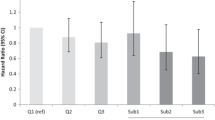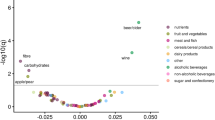Abstract
Background
Dietary fats and other constituents have been studied extensively in relation to breast cancer risk. Iron, an essential micronutrient with pro-oxidant properties, has received little attention, and specific fats may augment its toxicity. We investigated the effects of iron and fats from various food sources on the risk of breast cancer.
Methods
Participants in a population-based case–control study, 3,452 breast cancer cases, and 3,474 age-frequency-matched controls, completed in-person interviews, including a detailed food-frequency questionnaire. Plant- and animal-derived iron and fat intakes were derived from dietary intake data and food composition tables. Unconditional logistic regression models were used to study the independent and interactive effects of different forms of iron and fats on breast cancer risk.
Results
Animal-derived (largely heme) iron intake was positively associated with breast cancer risk (P trend < 0.01; OR = 1.49 in the highest vs. lowest quartile, 95% confidence interval [CI] 1.25–1.78) after adjustment for known risk factors, antioxidant vitamin and isoflavone intake, and vitamin supplement use. The effect of animal-derived iron was similar in pre- and postmenopausal women. Intake of animal-derived fats was also associated with increased risk (adjusted OR = 1.34, 95% CI 1.14–1.58), particularly after menopause. A significant interaction between iron and fat from animal sources was observed (P < 0.01).
Conclusions
A high intake of animal-derived (heme) iron may be associated with an increased risk of primary breast cancer in Chinese women, and saturated and mono-unsaturated fats that are also derived from animal sources may augment this effect. Combined reductions in animal-derived iron and fat consumption have the potential to reduce breast cancer risk.
Similar content being viewed by others
References
Kallianpur AR, Hall LD, Yadav M et al (2004) Increased prevalence of the HFE C282Y hemochromatosis allele in women with breast cancer. Cancer Epidemiol Biomarkers Prev 13:205–212
Symons MC, Gutteridge JM (1998) Free radicals and iron: chemistry, biology, and medicine. Oxford University Press, London
Stevens RG, Graubard BI, Micozzi MS et al (1994) Moderate elevation of body iron level and increased risk of cancer occurrence and death. Int J Cancer 56:364–369
Kato I, Dnistrian AM, Schwartz M et al (1999) Iron intake, body iron stores, and colorectal cancer risk in women: a nested case–control study. Int J Cancer 80:693–698
Chan AT, Ma J, Tranah GJ et al (2005) Hemochromatosis gene mutations, body iron stores, dietary iron, and risk of colorectal adenoma in women. J Natl Cancer Inst 97:917–926
Kuvibidila SR, Gauther T, Rayford W (2004) Serum ferritin levels and transferrin saturation in men with prostate cancer. J Natl Med Assoc 96:641–649
Carpenter CE, Mahoney AW (1992) Contributions of heme and nonheme iron to human nutrition. Crit Rev Food Sci Nutr 31:333–367
Hambraeus L (1999) Animal- and plant-food-based diets and iron status: benefits and costs. Proc Nutr Soc 58:235–242
Kallianpur AR. Iron and oxidative injury—a commentary on "Fatty acid-mediated iron translocation: a synergistic mechanism of oxidative injury" by D. Yao et al (2005). Free Radic Biol Med 39:1305–1309
Zheng W, Gustafson DR, Sinha R et al (1998) Well-done meat intake and the risk of breast cancer. J Natl Cancer Inst 90:1724–1729
Sinha R, Gustafson DR, Kulldorff M et al (2000) 2-Amino-1-methyl-6-phenylimidazo[4,5-b]pyridine, a carcinogen in high-temperature-cooked meat, and breast cancer risk. J Natl Cancer Inst 92:1352–1354
Shannon J, Cook LS, Stanford JL (2003) Dietary intake and risk of postmenopausal breast cancer (United States). Cancer Causes Control 14:19–27
Gonzalez CA (2006) Nutrition and cancer: the current epidemiological evidence. Br J Nutr 96(suppl 1):S42–S45
Boyd NF, Stone J, Vogt KN et al (2003) Dietary fat and breast cancer risk revisited: a meta-analysis of the published literature. Br J Cancer 89:1672–1685
Yao D, Shi W, Gou Y et al (2005) Fatty acid-mediated intracellular iron translocation: a synergistic mechanism of oxidative injury. Free Radic Biol Med 39:1385–1398
Gao Y-T, Shu X-O, Dai Q et al (2000) Association of menstrual and reproductive factors with breast cancer risk: results from the Shanghai Breast Cancer Study. Int J Cancer 87:295–300
Shu X-O, Yang G, Jin F et al (2004) Validity and reproducibility of the food frequency questionnaire used in the Shanghai Women's Health Study. Eur J Clin Nutr 58:17–23
Shrubsole MJ, Gao Y-T, Cai Q et al (2004) MTHFR polymorphisms, dietary folate intake, and breast cancer risk: results from the Shanghai Breast Cancer Study. Cancer Epidemiol Biomarkers Prev 13:190–196
Boyapati SM, Shu X-O, Ruan Z-X et al (2005) Soyfood intake and breast cancer survival: a follow-up of the Shanghai Breast Cancer Study. Breast Canc Res Treat 92:11–17
Negri E, La Vecchia C, Franceschi S et al (1996) Intake of selected micronutrients and the risk or breast cancer. Int J Cancer 65:140–144
Adzersen KH, Jess P, Freivogel KW et al (2003) Raw and cooked vegetables, fruits, and selected micronutrients, and breast cancer risk: a case–control study in Germany. Nutr Cancer 46:131–137
Wang F, Elliott RL, Head JF (1999) Inhibitory effect of deferoxamine mesylate and low iron diet on the 13762NF rat mammary adenocarcinoma. Anticancer Res 19:445–450
Stevens RG, Morris JE, Cordis GA et al (2003) Oxidative damage in colon and mammary tissue of the HFE knockout mouse. Free Radic Biol Med 34:1212–1216
Liehr JG, Jones JS (2001) Role of iron in estrogen-induced cancer. Curr Med Chem 8:839–849
Wyllie S, Liehr JG (1998) Enhancement of estrogen-induced renal tumorigenesis in hamsters by dietary iron. Carcinogenesis 19:1285–1290
Nelson RL (2001) Iron and colorectal cancer risk: human studies. Nutr Rev 59:140–148
Lee D-H, Anderson KE, Harnack LJ et al (2004) Heme iron, zinc, alcohol consumption, and colon cancer: Iowa Women's Health Study. J Natl Cancer Inst 96:403–407
Sesink AL, Termont DS, Kleibeuker JH (1999) Red meat and colon cancer: the cytotoxic and hyperproliferative effects of dietary heme. Cancer Res 59:5704–5709
Oates PS, West AR (2006) Heme in intestinal epithelial cell turnover, differentiation, detoxification, inflammation, carcinogenesis, absorption and motility. World J Gastroenterol 12:4281–4295
Cho E, Spiegelman D, Hunter DJ et al (2003) Premenopausal fat intake and risk of breast cancer. J Natl Cancer Inst 95:1079–1085
Cho E, Chen WY, Hunter DJ et al (2006) Red meat intake and risk of breast cancer among premenopausal women. Arch Intern Med 166:2253–2259
Hunter DJ, Spiegelman D, Hans-Olov A et al (1996) Cohort studies of fat intake and the risk of breast cancer—a pooled analysis. N Engl J Med 334:356–361
Missmer SA, Smith-Warner SA, Spiegelman D et al (2002) Meat and dairy food consumption and breast cancer: a pooled analysis of cohort studies. Int J Epidemiol 31:78–85
Dai Q, Shu X-O, Jin F et al (2002) Consumption of animal foods, cooking methods, and risk of breast cancer. Cancer Epidemiol Biomarkers Prev 11:801–808
Du S, Zhai F, Wang Y et al (2000) Current methods for estimating dietary iron bioavailability do not work in China. J Nutr 130:193–198
Prentice RL, Caan B, Chlebowski RT et al (2006) Low-fat dietary pattern and risk of invasive breast cancer. The Women's Health Initiative Randomized Controlled Dietary Modification Trial. J Am Med Assoc 295:629–642
Barnard RJ, Gonzalez JH, Liva ME et al (2006) Effects of a low-fat, high-fiber diet and exercise program on breast cancer risk factors in vivo and tumor cell growth and apoptosis in vitro. Nutr Cancer 55:28–34
Rock CL, Flatt SW, Thomson CA et al (2004) Effects of a high-fiber, low-fat diet intervention on serum concentrations of reproductive steroid hormones in women with a history of breast cancer. J Clin Oncol 22:2379–2387
Kushi L, Giovannucci E (2002) Dietary fat and cancer. Am J Med 113(suppl 9B):63S–70S
Zacharski LR, Ornstein DL, Woloshin S, Schwartz LM (2000) Association of age, sex, and race with body iron stores in adults: analysis of NHANES III data. Am Heart J 140:98–104
Sinha R, Cross A, Curtin J et al (2005) Development of a food frequency questionnaire module and databases for compounds in cooked and processed meats. Mol Nutr Food Res 49:648–655
Pierre F, Peiro G, Tache S (2006) New marker of colon cancer risk associated with heme intake: 1,4-dihydroxynonane mercapturic acid. Cancer Epidemiol Biomarkers Prev 15:2274–2279
Hanson LM, Engelman HM, Alekel DL et al (2006) Effects of soy isoflavones and phytate on homocysteine, C-reactive protein, and iron status in postmenopausal women. Am J Clin Nutr 84:774–780
Hallberg L, Hulthen L (2000) Prediction of dietary iron absorption: an algorithm for calculating absorption and bioavailability of dietary iron. Am J Clin Nutr 71:1147–1160
Martinez-Torres C, Leets I, Taylor P et al (1986) Heme, ferritin and vegetable iron absorption in humans from meals denatured of heme iron during the cooking of beef. J Nutr 116:1720–1725
Acknowledgements
We gratefully acknowledge the patients and research staff who participated in the Shanghai Breast Cancer Study. We also thank Dr. Hui Cai for his analytical support. This work was supported by the Office of Research in Women’s Health via a National Institutes of Health Mentored Career Development (BIRCWH) Award to Dr. Kallianpur (5K12HD04348-04) and by USPHS Grant R01CA64277 (Dr. Zheng).
Author information
Authors and Affiliations
Corresponding author
Rights and permissions
About this article
Cite this article
Kallianpur, A.R., Lee, SA., Gao, YT. et al. Dietary animal-derived iron and fat intake and breast cancer risk in the Shanghai Breast Cancer Study. Breast Cancer Res Treat 107, 123–132 (2008). https://doi.org/10.1007/s10549-007-9538-3
Received:
Accepted:
Published:
Issue Date:
DOI: https://doi.org/10.1007/s10549-007-9538-3




